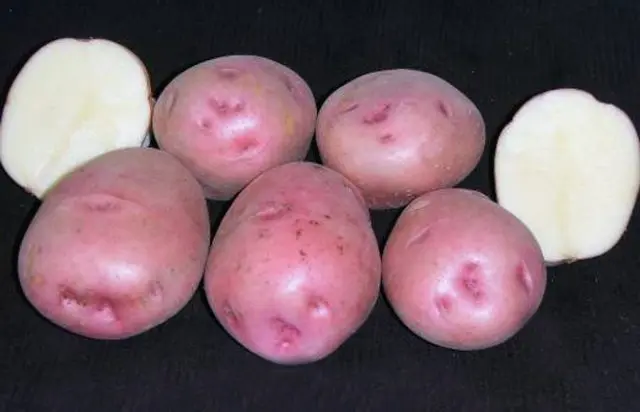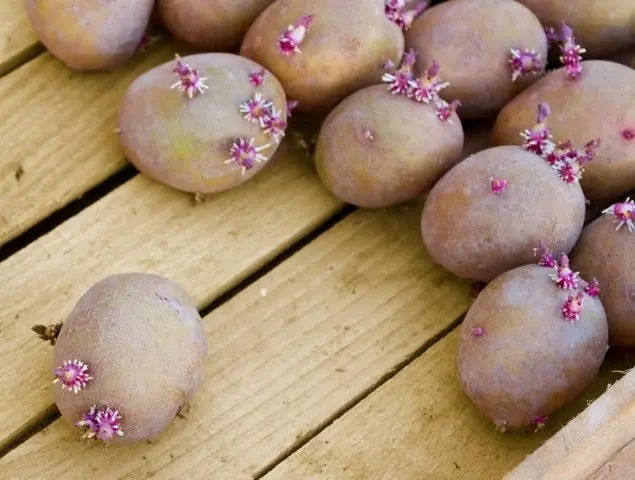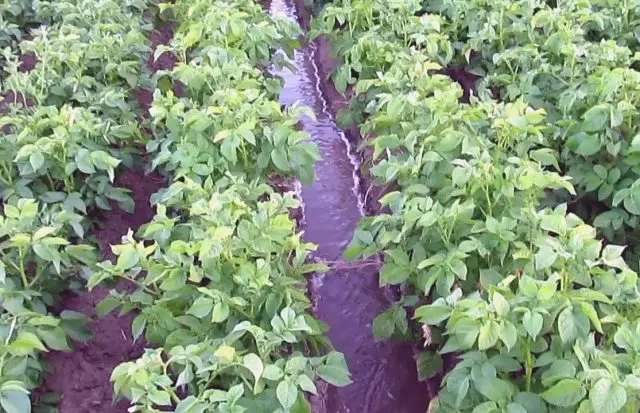Contents
Potato varieties Lilac fog – a culture of breeding. Included in the State Register of Breeding Achievements in 2011. Approved for use in the North-West and Far East regions. Tubers of high commercial qualities are well suited for cultivation in private farms, as well as for subsequent sale.
Description of the potato variety Lilac fog
Potatoes Lilac mist of average term of maturing. The period from germination to technical ripeness takes 90-110 days. The potato bush of the Lilac fog variety grows moderately sprawling, 50-60 cm high. The leaves are large, green in color, with a slight waviness of the edge. The whisk is large. Flower color is purple.

The tubers of the Lilac fog variety are oval-round in shape with a red skin and small eyes. The surface and color are even. The flesh is light yellow. The mass of one potato is from 90 to 159 g. The variety has high marketability rates – 94% and keeping quality – 98%. When stored for a long time does not germinate. 7-10 potatoes appear on the bush. Maintains the qualities of the variety during long-term planting of its own seed material.
Taste qualities of potatoes Lilac fog
In the characteristics of the Lilac fog potato, it is written that the starch content in tubers is 14,4-17,2%. Which means moderate digestibility with shape retention. Appointment of potatoes table. The taste is good. Suitable for various types of cooking. During heat treatment does not change color and does not darken. Taste may vary depending on growing conditions.
Pros and cons of the variety
The main advantage of the variety is that it does not degenerate for a long time, unlike other varieties. Lilac fog potatoes can be grown continuously for about 8-9 years.
Other advantages of Lilac fog potatoes:
- average terms of maturing;
- good taste;
- excellent keeping quality, in which sprouts do not appear for a long time;
- resistance to certain diseases;
- high marketability of tubers;
- low risk of damage during excavation;
- good transport qualities.
The disadvantages of the Lilac fog variety include not the highest yield, poor tolerance of elevated air temperatures.
Planting and caring for potatoes Lilac fog
Growing tubers of the Lilac fog variety requires standard agricultural practices. To obtain a high yield during planting, it is necessary to observe crop rotation. It is best to plant the crop in areas where green manure and crops such as zucchini, legumes and onions have previously grown. Potatoes are returned to their original place only after 3 years.
Selection and preparation of the landing site
Dry, flat areas are chosen for planting potatoes of the Lilac fog variety. The preferred soil compositions are loose, sandy loam. The air permeability of the soil is necessary for high-quality tuberization.
In one growing season, potatoes take a lot of nutrients from the soil, so it must be grown on rested and fertile soils. The soil for planting needs to be deoxidized. Landing is recommended to be carried out from north to south, for uniform access of light to all plants.
Preparation of planting material
Seed potatoes are harvested after harvest in the fall. The selected seed before storage is green in the light for 2 weeks. Green tubers are less susceptible to diseases and damage by rodents during storage. Seed material must be stored in cool rooms so that it does not germinate ahead of time.
Medium-sized tubers are chosen for germination, the more eyes they have, the better for productivity. But to cut potatoes of the Lilac fog variety for planting or not, everyone decides for themselves.
For proper preparation in anticipation of the sowing season, tubers taken from storage must have dormant buds. For germination, they are taken out 3 weeks before planting. It is not necessary to take out the tubers prematurely; sprouts of about 1 cm are enough for planting. Planting seed tubers with overgrown, filamentous, long sprouts greatly reduces the yield.

Germinate planting potatoes in the light. In the first week – at a temperature of + 18 … + 20 ° С. For the next 2 weeks, the temperature is reduced to + 10 … + 15 ° C, shifting the potatoes to a dark place. In this case, powerful, bright and healthy shoots appear.
A few hours before planting, the tubers are treated with insecticide-fungicidal preparations. Processing provides comprehensive protection of tubers from pests and diseases. After spraying, the seed must be dried. When tuber processing, there is no need to spray on the bush, as well as the collection of beetles.
Rules of landing
Planting potatoes of the Lilac fog variety begins in May. Depending on the region of cultivation, the readiness of the soil becomes a guideline for planting. It must be mature and warmed up to the planting depth. Usually, the soil warms up to the desired temperature after establishing a constant air temperature above + 10 ° C.
The maturity of the soil is determined by the compression of an earthen clod, while it must be formed, and when it falls, it should be broken into small and large fractions. This shows that the soil has the right amount of moisture.
Fertilizers are applied during the general plowing of the field or directly when planting in the hole. To do this, use complexes of mineral fertilizers, as well as natural nutrients. Mustard cake, fishmeal or bokashi can replace the action of manure or humus. When applying mineral fertilizers, they are scattered from the bottom or top of the planting, but so that the tuber does not come into direct contact with them. Natural elements are mixed with the soil.
When planting, the tubers are deepened by 7-8 cm. Potatoes love warm soil. Therefore, deep planting will give a small crop with a large volume of tops. Potatoes of the Lilac fog variety need sufficient areas of nutrition and heating, so the distance in the row between the holes is 40 cm, and between the rows – 70-80 cm. At the same time, a linear or staggered layout is used. Good ventilation of the bushes reduces the risk of late blight.
Watering and top dressing
Potatoes of the Lilac fog variety are demanding on watering; on dry soils, the yield is reduced. Regular watering improves the absorption of nutrients, potatoes have a good growth, even shape, and their palatability increases. One of the best irrigation for potatoes of the Lilac fog variety is considered drip and in the furrows.
Until the emergence of seedlings, plantings are not watered. For this phase of growth, there is enough moisture in the seed, and the lack of watering provokes the correct development of the root system. After the appearance of green shoots, the plants are watered at the rate of 2-3 liters per bush.
You can water only in the evening or cloudy weather. On a sunny day, watering provokes the evaporation of moisture, which causes leaf burns and provides an environment for the occurrence of diseases.
Potatoes of the Lilac fog variety are watered as the soil dries with heated water. In hot weather, 1 watering per week is carried out, in moderate weather – 1 time in 2 weeks. Stop watering a few weeks before harvest.

The need for the addition of trace elements depends on the soil on which Lilac fog potatoes are grown. For a culture to grow, it needs:
- 100 g potassium;
- 50 g nitrogen;
- 30 g of phosphorus.
Ash is used separately from nitrogen fertilizers, because such a compound neutralizes the effect of nitrogen. The interval between the introduction of elements should be a month.
Such organic fertilizer as manure is used only when rotted to avoid the formation of various rots of tubers and scab.
With poor germination, infusions of bird droppings and grass are used. Before flowering, potash-phosphorus fertilizers without chlorine are applied.
Loosening and weeding
Loosening and weeding are necessary for the culture for better air supply to the tubers. The first loosening is carried out already on the 5th day after planting. Harrowing helps to break up the soil crust that forms after watering or rain.
Loosening is often combined with weeding, removing or cutting weeds with a hand cultivator. Loosening and weeding, as well as hilling, can be replaced by the method of growing potatoes in a layer of mulch. But it requires a lot of cut grass.
Hilling
The first hilling of the Lilac fog variety potato is carried out with the germination of the aerial part by 5-7 cm. The earth is raked under the bush so that 2-3 cm of the vegetative mass remains. Hilling is required in order to form additional stolons, on which new tubers are formed. Hilling with the formation of a high ridge allows you to maintain a suitable temperature for growing, reduces the number of weeds.
The second hilling is carried out 2 weeks after the first, when the bushes reach 20-25 cm in height. Proper and timely hilling gives a 20-30% increase in yield.
Diseases and pests
A variety of potato pests are capable of destroying and damaging all parts of the plant. The vegetative mass is harmed by Colorado leaf beetles, various caterpillars, scoops. Tubers damage the wireworm, nematodes, bears.
Weak plants growing on depleted soils are more susceptible to attack by insect pests. Prevention is soil preparation and dressing of tubers before planting.
According to the originator of the variety, the culture is resistant to such diseases:
- potato cancer;
- curling leaves.
Moderately resistant to:
- wrinkled and striped mosaic;
- phytophthora.
Plants are susceptible to golden potato cyst nematode.
Potato yield
Potato variety Lilac mist can form large tubers, their number depends on the distance between the bushes. With a close planting of tubers, more tubers are formed, but smaller in size and vice versa. On average, their number reaches 4,5-5 kg per square meter. m. The amount of crop is also affected by the regularity of watering and the condition of the soil.
Harvesting and storage
Harvest of potato variety Lilac fog is harvested 3 months after germination. Some time before digging, the tops are cut off. Root crops after harvesting tops are not left in the soil for more than 3 weeks. After harvesting, the tubers are dried, the seed material is selected. Lay for storage in rooms with a constant positive temperature not higher than +5°C.
Conclusion
Potatoes of the Lilac fog variety are suitable for growing in personal and small farms. Culture does not degenerate for a long time for 8-9 years. Smooth, commercial tubers are well stored. According to the description, reviews and photos, the Lilac fog potato variety is a table variety, so the fruits are suitable for various culinary treatments.









